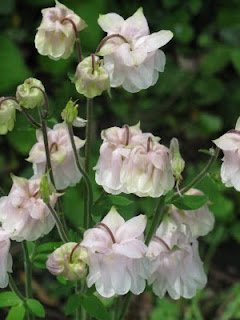The first time I heard entomologist Doug Tallamy speak was at a Master
Gardener training day. It was, I think, six years ago, and it was a real “aha”
moment for me. I hadn’t had a yard of my own for that long, but I was already
an enthusiastic grower of native plants.
I understood some of the benefits of growing plants native to the local
area: they were less likely to require a lot of maintenance once established,
less likely to become invasive, helped establish a sense of place, helped support
wildlife, etc. What hadn’t occurred to me, or to a lot of other people, I
think, was the critical importance of native plants as a food source for native
insects.
 In that talk, and in his subsequently published book Bringing Nature Home:How Native Plants Sustain Wildlife in Our Gardens, Tallamy explained
that most native insects have evolved to feed on only a small number of native
plants. Without these specific plants, the insects can't survive. This in turn
impacts the species that depend on insects for food; for example, the vast
majority of migratory birds raise their young on insects.
In that talk, and in his subsequently published book Bringing Nature Home:How Native Plants Sustain Wildlife in Our Gardens, Tallamy explained
that most native insects have evolved to feed on only a small number of native
plants. Without these specific plants, the insects can't survive. This in turn
impacts the species that depend on insects for food; for example, the vast
majority of migratory birds raise their young on insects.
Other animals also rely on
insects for some part of their diet. Without native insects, a huge food source
disappears; non-native plants are far less productive of insect biomass. These
insects, in other words, are a critical part of the food webs on which life
depends. The lawns and non-native plants of suburban lawns and gardens do not
provide food for native insects – they are basically food deserts. Tallamy thus
built a quite compelling case for homeowners and gardeners to incorporate
native plants into their yards and as much as possible.
Last week I heard Tallamy speak again at a Master Gardener training day. This
time his focus was broader: on the need for biological corridors, which, he
said, are not just corridors for animals to pass through, but habitats in
themselves. At this point, he maintained, biodiversity cannot be sustained by
parks and preserves alone. We must restore land between existing landscape
fragments, everywhere. Obvious places to do so are along roadways and power
lines. Roadways can be planted with trees; power lines, as they pass through
the landscape, are usually mowed and can be good edge habitat. Beyond that, if
we turned half of all existing lawn into habitat we would be creating a
"Homegrown National Park" of over 20 million acres, which would go a
long way toward protecting future biodiversity.
We gardeners are lucky, I think. We can hear and
understand the message about loss of biodiversity, which is pretty dire. At the
same time, we’re in a position to contribute to a solution, simply by doing
something we love, gardening, with
nature instead of in opposition to her. “The landscape challenge of our time,”
says Douglas Tallamy, “is, more plants!” That’s something to make any true
gardener’s heart beat faster!














